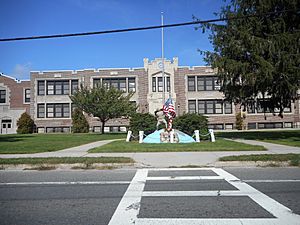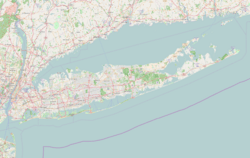Eastport, New York facts for kids
Quick facts for kids
Eastport, New York
|
|
|---|---|

The Eastport Elementary School on Montauk Highway with a World War I memorial in front of it.
|
|
 |
|
| Country | United States |
| State | New York |
| County | Suffolk |
| Area | |
| • Total | 4.58 sq mi (11.85 km2) |
| • Land | 4.45 sq mi (11.52 km2) |
| • Water | 0.13 sq mi (0.33 km2) |
| Elevation | 30 ft (9 m) |
| Population
(2020)
|
|
| • Total | 2,219 |
| • Density | 498.88/sq mi (192.62/km2) |
| Time zone | UTC−05:00 (Eastern Time Zone) |
| • Summer (DST) | UTC−04:00 |
| ZIP Code |
11941
|
| Area code(s) | 631, 934 |
| FIPS code | 36-22810 |
| GNIS feature ID | 0949307 |
Eastport is a small community in Suffolk County, New York. It's known as a hamlet and a "census-designated place" (CDP). This means it's a specific area defined by the U.S. Census Bureau for collecting population data. Eastport is located on the South Shore of Long Island. In 2020, about 2,219 people lived there.
Contents
History of Eastport
Eastport was originally part of the land belonging to the Shinnecock Indian Nation. The community we know today started in 1772. That year, two men built a dam. This dam created a body of water called West Pond. The pond became a natural border between the towns of Brookhaven and Southampton.
Below the dam, the men built two mills: a sawmill for cutting wood and a gristmill for grinding grain. By 1845, the area east of West Pond was known as Waterville. The land to the west was called Seatuck, named after a nearby creek.
In 1860, the United States Postal Department needed a clear name for the area to deliver mail. They decided to combine Waterville and Seatuck. The name Seatuck was dropped because it sounded too much like Setauket, New York. So, the combined area was officially named Eastport.
Eastport's Duck Industry
For a long time, Eastport was famous as the center of Long Island's duck farming industry. The first duck farms started here in the 1880s. In the early 1900s, Eastport was the main place for raising Long Island ducks. At its peak, 29 farms produced about 6.5 million ducks each year!
The Long Island Duck Growers' Association was set up in Eastport by 1915. Later, in 1949, Cornell University opened the Duck Disease Research Laboratory in Eastport. This lab helped keep the ducks healthy. They even found the first cases of certain duck diseases in the United States here.
Today, most of the duck farms are gone. The families who owned them have sold their valuable waterfront land. This land is now used for building homes.
Geography of Eastport
Eastport is unique because it sits right on the border between two towns: Brookhaven and Southampton.
The U.S. Census Bureau says that Eastport covers about 14.0 square kilometers (about 5.4 square miles). Most of this area, about 13.6 square kilometers (5.2 square miles), is land. The rest, about 0.3 square kilometers (0.1 square miles), is water.
Eastport Population Facts
| Historical population | |||
|---|---|---|---|
| Census | Pop. | %± | |
| 2020 | 2,219 | — | |
| U.S. Decennial Census | |||
In 2020, the census showed that 2,219 people lived in Eastport. There were 656 households, which are groups of people living together in one home. Most households, about 83%, were married couples living together. About 12% of people lived alone.
The average household had 3 people. The average family had 3.24 people. The median age in Eastport was about 45.3 years old. This means half the people were younger than 45.3, and half were older. About 12.6% of the population identified as Hispanic or Latino.
The typical income for a household in Eastport was $121,250 per year. The average income for each person was $45,891. About 6% of the population lived below the poverty threshold.
Education in Eastport
Students in Eastport attend schools within the Eastport-South Manor Central School District.
Notable People from Eastport
- Scott Disick, an American media personality.
See also
 In Spanish: Eastport (Nueva York) para niños
In Spanish: Eastport (Nueva York) para niños



